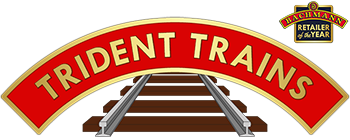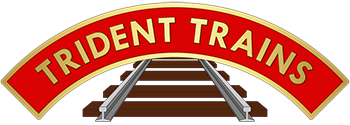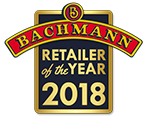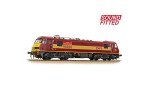Search results
Number of items to display per page: 5 | 10 | 20 | Show All
 32-619SF
32-619SFClass 90 90030 'Crewe Locomotive Works' EWS With DCC Sound
SOUNDS
F0 - Directional Lights - On/Off (plus Light Switch Sound)
F1 - Sound - On/Off (plus Battery Switch and Compressor Sounds)
F2 - Brake
F3 - Low Horn (Playable)
F4 - Two-Tone Horn
F5 - Parking Brake On/Off (Loco won’t move with Parking Brake On)
F6 - On - Pantograph Up / Off - Pantograph Down (with Sounds)
F7 - Flange Squeal (Speed Related)
F8 - Windscreen Wipers
F9 - Air Dump
F10 - On - Guard’s Whistle / Off - Driver’s Response
F11 - Spirax Valve
F12 - On - Pantograph Up (Sounds Only) / Off - Pantograph Down (Sounds Only)
F13 - AWS
F14 - Directional Lights - On - Day Mode / Off - Night Mode
F15 - Cab Lights - On/Off (Direction Dependent)
F16 - Coupling Up
F17 - Uncoupling
F18 - On - Cab Door Open / Off - Cab Door Shut
F19 - Uncoupling Movement Cycle
F20 - Directional Lights Off (Non-Pantograph End)
F21 - Directional Lights Off (Pantograph End)
F22 - Fire Alarm Test
F23 - Volume Control (6 levels)
Analogue Users: Please note that any automated drive sounds will be played when this model is used on analogue control (DC) straight from the box!
CLASS 90 HISTORY
Fifty Class 90 locomotives were ordered by British Rail in 1986 to replace the ageing Class 85 fleet on West Coast Main Line duties, whilst also allowing BR to cascade a number of Class 86s to East Anglia. Constructed at British Rail Engineering Limited, Crewe, the new locomotives were initially classified as 87/2s however this was soon changed to Class 90 as the design featured a completely new body-shell – although much of the technology within was shared with the Class 87s.
Construction of the 110mph rated locomotives was completed in 1990 and the fleet was split between different sectors of British Rail – 15 were allocated to InterCity services, five for Rail Express Systems (mail and parcels traffic) and the remaining 30 for Railfreight Distribution. Most of those allocated to Railfreight Distribution would later be downgraded to 75mph and reclassified as 90/1s numbered in the 901xx series following work to isolate the Electric Train Heating and push-pull equipment making them dedicated freight locos.
Upon privatisation the Class 90 fleet was split between Virgin Trains, EWS and Freightliner. By 1999 all of the Class 90/1s acquired by EWS had been converted back to 90/0s due to an increased requirement for passenger locomotives to work contracted ScotRail sleeper trains and for hire to GNER for East Coast Main Line services. Further renumbering by EWS occurred when nine locos were fitted with different brake blocks and these became Class 90/2s numbered in the 902xx series. The Freightliner locos were also converted back to their original specification in the early 2000s.
The Class 90s have carried numerous liveries including three decorated in European liveries for the Freightconnection event in 1992 which coincided with the opening of the Channel Tunnel to freight services. No. 90128 was decorated in SNCB turquoise (Belgium), No. 90129 in DB red (Germany) and No. 90130 in SNCF orange and grey (France) and each carried the name Freightconnection in their respective languages, alongside No. 90022 which was named ‘Freightconnection’ and carried Railfreight Distribution livery.
The majority of the Class have carried names whilst in service and the 90s have appeared a variety of other post-Privatisation liveries such as GNER, DB Schenker, First ScotRail, One (Anglia), Greater Anglia, National Express, DRS and Malcolm Logistics. Today, Class 90s remain in operation with Freightliner, DB Cargo UK (ex-EWS/DB Schenker) and most recently Locomotive Services which has acquired Nos. 90001 and 90002 and repainted them into InterCity Swallow livery for use on charters and excursions.
Prev | Next


















